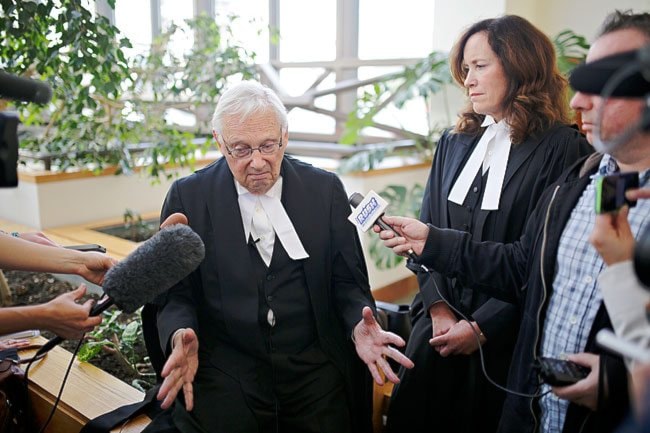Well, it looks like the crystal ball at the Yukon News could use a spit shine. We’ve previously predicted in these pages that the Yukon government would keep on losing in its long-running court battle with First Nations over the fate of the Peel watershed. Instead, the Court of Appeal offered a decision on Wednesday that is probably the best that the government could have hoped for, and should be considered a qualified victory of sorts.
That hasn’t stopped many people, including both of Yukon’s opposition parties, from concluding that the Yukon government lost the case. It didn’t exactly inspire confidence to see NDP Leader Liz Hanson share a post by her party that says “We’re brimming with hope: the Yukon Court of Appeal just rejected the Yukon Party government’s appeal in the Peel watershed case,” right underneath a screen grab that shows the decision’s conclusion that the appeal would, in fact, be “allowed in part.”
Why the confusion? Well, to nobody’s surprise, the appeals judges found the Yukon government behaved badly during its dealings with First Nations during planning talks, concluding that “Yukon undermined reconciliation by failing to honour the letter and spirit of its treaty obligations.” And the appeals judges agreed with an earlier Supreme Court decision that quashed the plan rammed through by the Yukon government, which nearly inverted the planning commission’s recommendations by opening most of the watershed up for development.
Upon hearing this much, it seems some didn’t bother reading any further in the judgment, and ended up missing the real take-away.
The appeals judges ended up rejecting a key contention made by Thomas Berger, the famed aboriginal lawyer who represented the plaintiffs - namely, that the Yukon government should not get a chance at a do-over by going back a few steps in the process and presenting the type of plan it wants to affected First Nations. Berger warned that allowing this would amount to rewarding the government for its dirty deeds.
Supreme Court Judge Ron Veale agreed with this conclusion. But the appeals judges thought differently, saying that allowing a re-do at an earlier stage “would not permit Yukon ‘to benefit from its flawed process’; it would allow the process to unfold as it was meant to.”
The Yukon won’t be allowed to simply submit its own plan for the watershed at an earlier stage, the judges say. Instead, it must go through another round of consultations with First Nations and the planning commission, providing the sort of details it was supposed to have provided in the first place and giving First Nations and the planning commission a chance to respond. But it looks like the government could jump through these hoops and still lawfully push through a plan that would leave much of the watershed open to development, as Berger now warns.
In fact, this is an outcome that the Yukon government has always asked for, barring a fantasy ruling that upheld the government’s dumb-as-nails behaviour up until this point.
Lest there be any remaining confusion, the Yukon government has issued a statement that says it’s pleased with the outcome. The plaintiffs, meanwhile, are considering taking the case to the Supreme Court of Canada. These would be strange responses if the Yukon government had, in fact, lost.
Yet none of this should suggest that the government will actually see its dreams realized of iron ore trucks rumbling along newly-graded roads through what was once near-pristine wilderness in the Peel. Even if the government is able to put in place the plan it wants, and setting aside the questionable economics of building a mine in such a far-flung spot, First Nations opposition to mining projects remains a kiss of death for proponents. And if the Yukon Party has accomplished anything with the great mess it has created in the name of developing the Peel, it has been to galvanize opposition to development in the watershed. The Peel debacle will stand as an enduring example of the Yukon Party’s utter inability to play well with others.
Our territorial leaders had many chances, during seven long years of planning talks, to make an upfront, reasoned pitch that the benefits of new mines in the region would outweigh any loss of natural splendour. Instead they took a route that was cowardly, contemptuous of the public and fundamentally dishonest.
Remember, this is a gang that tried to suppress government information that buttressed calls for conservation in the region, and steadfastly refused to give any sense of how much development it wanted for the region up until the planning commission had wrapped up - and, conveniently enough, until after a territorial election. This is a gang that always insisted it would respect Yukon’s treaties with First Nations, particularly at the moment when it was undermining these agreements. This is a gang that made pie-in-the-sky promises that they could deliver a plan that would please all involved, rather than engaging in an adult discussion about necessarily painful trade-offs.
Now our leaders hope to somehow patch things up and come to terms with the chiefs they’ve been feuding with all this time. Good luck with that. So far our premier hasn’t even been willing to admit any culpability for the mess he played a large part in creating. To make headway, that would be a good place to start.
Correction: An earlier version of this editorial misidentified the Supreme Court judge who ruled on the Peel case. We're sorry for the mix-up.
